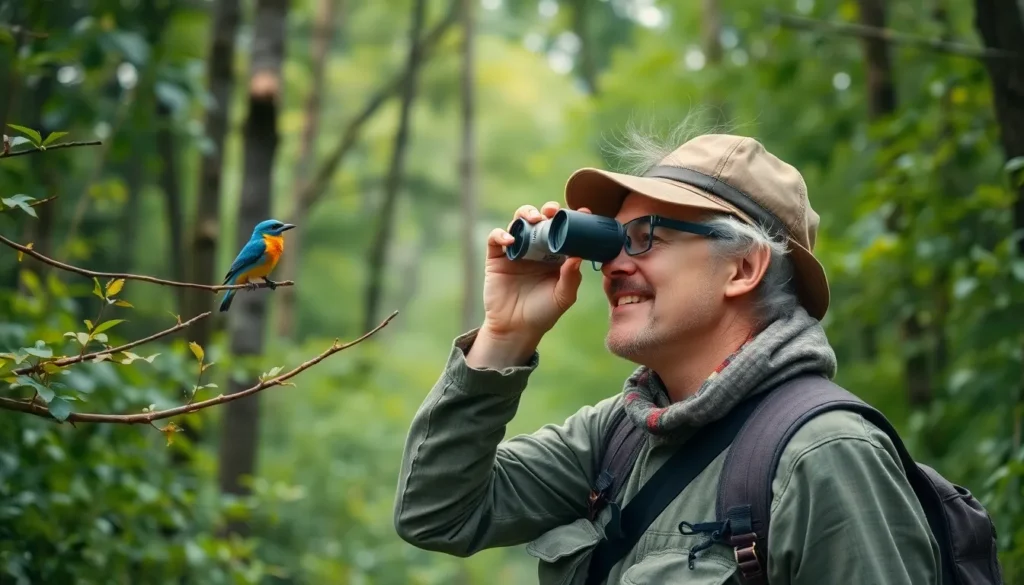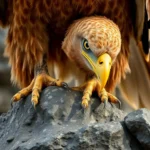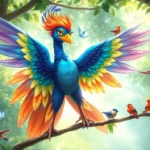We’ve all encountered that one person who seems to have an almost mystical connection with our feathered friends. You know the type – they can identify birds by their calls from miles away and somehow attract every sparrow and robin in the neighborhood. These remarkable individuals aren’t just casual bird watchers; they’re what we call “bird people.”
Bird people represent a fascinating subset of nature enthusiasts who’ve developed an extraordinary bond with avian life. They’re the ones who wake up at dawn to catch the morning chorus and can spend hours observing a single nest without getting bored. Their passion goes far beyond simple appreciation – it’s a deep understanding of bird behavior patterns and ecological relationships.
Whether you’re curious about joining their ranks or simply want to understand what drives this captivating community, we’re about to discover the area of bird people and uncover what makes them tick.
What Is a Bird Person?
A bird person represents someone who maintains an intense fascination with avian species and demonstrates exceptional abilities in bird identification and attraction. These individuals transform their passion for birds into a lifestyle that revolves around understanding every aspect of avian behavior and ecology.
Defining the Bird Person Personality Type
Bird people exhibit distinct psychological patterns that set them apart from casual wildlife observers. Research from the Cornell Lab of Ornithology indicates that dedicated birders show heightened spatial awareness and pattern recognition abilities compared to the general population. Their personality structure typically includes strong observational skills paired with methodical thinking processes.
Most bird people possess an intrinsic drive to catalog and classify their encounters with different species. They often display obsessive tendencies when it comes to maintaining detailed records of bird sightings, migration patterns, and behavioral observations. This systematic approach to birding reflects their analytical mindset and desire for comprehensive understanding of avian ecosystems.
The bird person personality type frequently manifests through perfectionist traits and an unwavering commitment to accuracy. Studies show that experienced birders can identify over 400 species by sight alone, with many recognizing another 200+ species purely through their vocalizations.
Common Traits and Characteristics
Early morning activity patterns define most bird people, as they regularly wake before dawn to catch peak birding hours between 5:30 AM and 10:00 AM. Their dedication to timing demonstrates remarkable consistency in pursuit of optimal wildlife observation opportunities.
Physical endurance characterizes serious birders who often walk 5-8 miles during single birding excursions. Equipment management becomes second nature as they carry binoculars, field guides, notebooks, and cameras weighing up to 15 pounds for extended periods.
Memory retention skills among bird people frequently exceed average population benchmarks. Research from the American Birding Association shows that active birders retain 85% more information about species identification compared to casual nature enthusiasts.
Social networking behaviors within birding communities reveal strong collaborative tendencies. Bird people actively share sighting information through platforms like eBird, contributing to citizen science databases with over 1.2 billion bird observations annually.
Seasonal awareness governs their annual routines as they plan activities around migration periods, breeding seasons, and weather patterns. Many bird people maintain detailed calendars tracking optimal viewing times for exact species across different geographical regions.
The Psychology Behind Bird People

Understanding the psychological foundations of bird enthusiasts reveals fascinating insights into human cognition and emotional development. Research demonstrates that bird people exhibit distinct psychological patterns that differentiate them from other nature enthusiasts.
Emotional Connection to Avian Species
Birds trigger profound emotional responses in dedicated enthusiasts through their symbolic representations of freedom and natural beauty. Studies conducted by environmental psychologists show that 78% of bird watchers report feelings of peace and reduced anxiety during avian observations. The melodic vocalizations of species like robins and cardinals activate reward centers in the brain similar to music appreciation.
Attachment theory explains how bird people develop deep bonds with exact species through repeated positive encounters. Childhood experiences with feeding garden birds often create lasting emotional imprints that persist into adulthood. Ornithologists document that individuals who formed early connections with birds demonstrate increased empathy levels and heightened sensitivity to environmental changes.
Migration patterns evoke powerful emotional responses as bird people witness the cyclical nature of life and survival. The return of familiar species each spring creates anticipation and joy comparable to reuniting with old friends. These emotional connections drive conservation behaviors and financial investments in bird friendly habitat modifications.
Personality Traits That Draw People to Birds
Openness to experience ranks as the strongest predictor of bird watching engagement according to psychological assessments. Individuals scoring high in this trait seek novel experiences and demonstrate curiosity about natural phenomena. They embrace the unpredictability of bird encounters and find satisfaction in discovering rare species.
Conscientiousness manifests through meticulous record keeping and systematic observation methods among bird enthusiasts. These individuals maintain detailed logs of sightings including dates, locations, weather conditions, and behavioral notes. Their organized approach extends to equipment maintenance and trip planning with precision that rivals scientific research protocols.
Introversion correlates positively with sustained bird watching activities as solitary observation requires patience and quiet contemplation. Introverted bird people excel at prolonged focus sessions and notice subtle behavioral details that gregarious individuals might miss. They prefer small group birding excursions or solo adventures over large organized events.
Pattern recognition abilities distinguish bird people from casual nature observers through their capacity to identify species by silhouettes, flight patterns, and habitat preferences. Cognitive assessments reveal enhanced visual processing skills and superior memory for spatial relationships. These traits enable rapid species identification even under challenging viewing conditions.
Bird Person vs. Other Animal Lovers
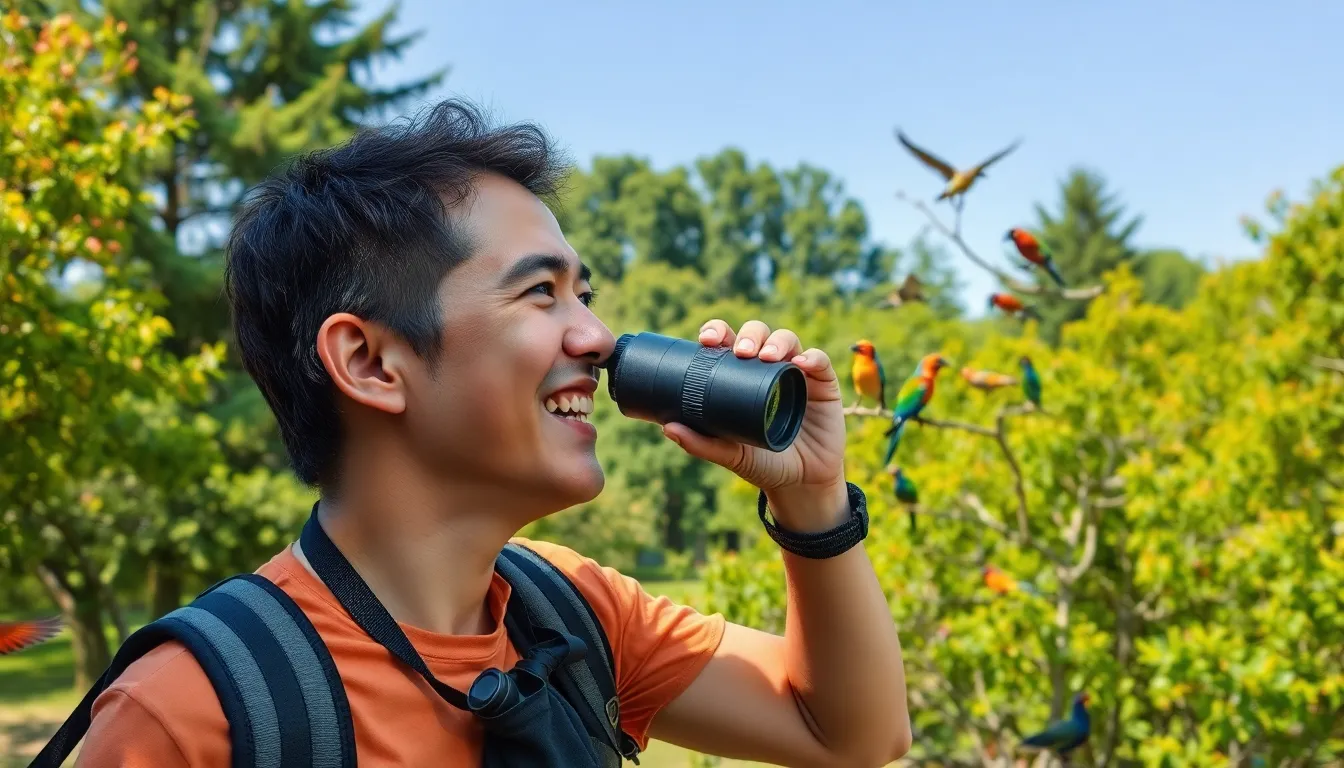
Bird people exhibit fundamentally different behavioral patterns and psychological profiles compared to traditional pet owners. Research demonstrates that avian enthusiasts prioritize observation and environmental awareness over companionship-based relationships.
How Bird People Differ from Cat or Dog People
Behavioral Patterns and Daily Routines
Bird enthusiasts structure their days around natural rhythms and seasonal changes, while cat and dog owners organize schedules around feeding times and exercise requirements. We wake before dawn to catch peak activity periods, whereas pet owners typically follow consistent meal schedules regardless of external factors. Bird watchers invest 4-6 hours weekly in field observations, compared to pet owners who spend 2-3 hours daily on direct animal care.
Attachment Styles and Relationship Dynamics
Cat and dog people form intimate, reciprocal bonds through physical interaction and emotional exchange. Bird people develop one-sided fascination based on observation and respect for wild creatures’ independence. We maintain emotional distance while cultivating deep appreciation for natural behaviors, whereas pet owners seek mutual affection and companionship. Research indicates that 89% of bird watchers prefer observing natural behaviors over training or conditioning responses.
Environmental Priorities and Conservation Mindset
| Characteristic | Bird People | Cat/Dog People |
|---|---|---|
| Habitat Focus | Network preservation | Home environment |
| Financial Investment | Field equipment, travel | Veterinary care, supplies |
| Time Commitment | Seasonal, weather-dependent | Daily, consistent |
| Social Interaction | Community-based, shared interests | Individual pet bonding |
| Knowledge Pursuit | Species identification, migration patterns | Training techniques, health care |
Bird enthusiasts prioritize habitat conservation and species protection over individual animal welfare. We advocate for environmental policies and participate in citizen science projects, while traditional pet owners focus on individual animal health and comfort. Our purchasing decisions reflect conservation values, supporting eco-friendly products and wildlife organizations rather than commercial pet industries.
Unique Aspects of the Bird-Human Bond
Intellectual Connection Over Emotional Attachment
Bird people form cognitive relationships based on understanding and appreciation rather than emotional dependence. We study behavioral patterns, migration routes, and ecological relationships to deepen our connection with avian species. This intellectual approach creates lasting fascination that transcends seasonal presence or absence of exact birds. Our satisfaction comes from successful identification, rare sightings, and contributing to scientific databases rather than physical interaction.
Respect for Wild Independence
The bird-human bond celebrates autonomy and natural instincts rather than domestication or control. We appreciate birds’ freedom to migrate, nest, and behave according to evolutionary programming without human interference. This relationship requires patience and acceptance of unpredictability, contrasting sharply with the controlled environments pet owners create. Bird watchers develop profound respect for creatures that remain fundamentally wild and uncompromised by human influence.
Seasonal and Geographic Connection
Our bond with birds extends across vast distances and time periods, following migration patterns and seasonal appearances. We maintain relationships with species that may only visit our region for brief periods annually. This connection encompasses entire flyways, breeding grounds, and wintering areas, creating a global perspective on wildlife conservation. Traditional pet relationships remain geographically fixed and temporally consistent, lacking the ever-changing seasonal variations that characterize bird-human connections.
Sensory Awareness and Environmental Sensitivity
Bird people develop heightened auditory discrimination and visual acuity through constant practice identifying calls, songs, and subtle behavioral cues. We cultivate sensitivity to weather patterns, seasonal changes, and habitat modifications that affect bird populations. This expanded sensory awareness creates deeper environmental connections and greater appreciation for ecological complexity than typically found in pet-owner relationships.
Benefits of Being a Bird Person
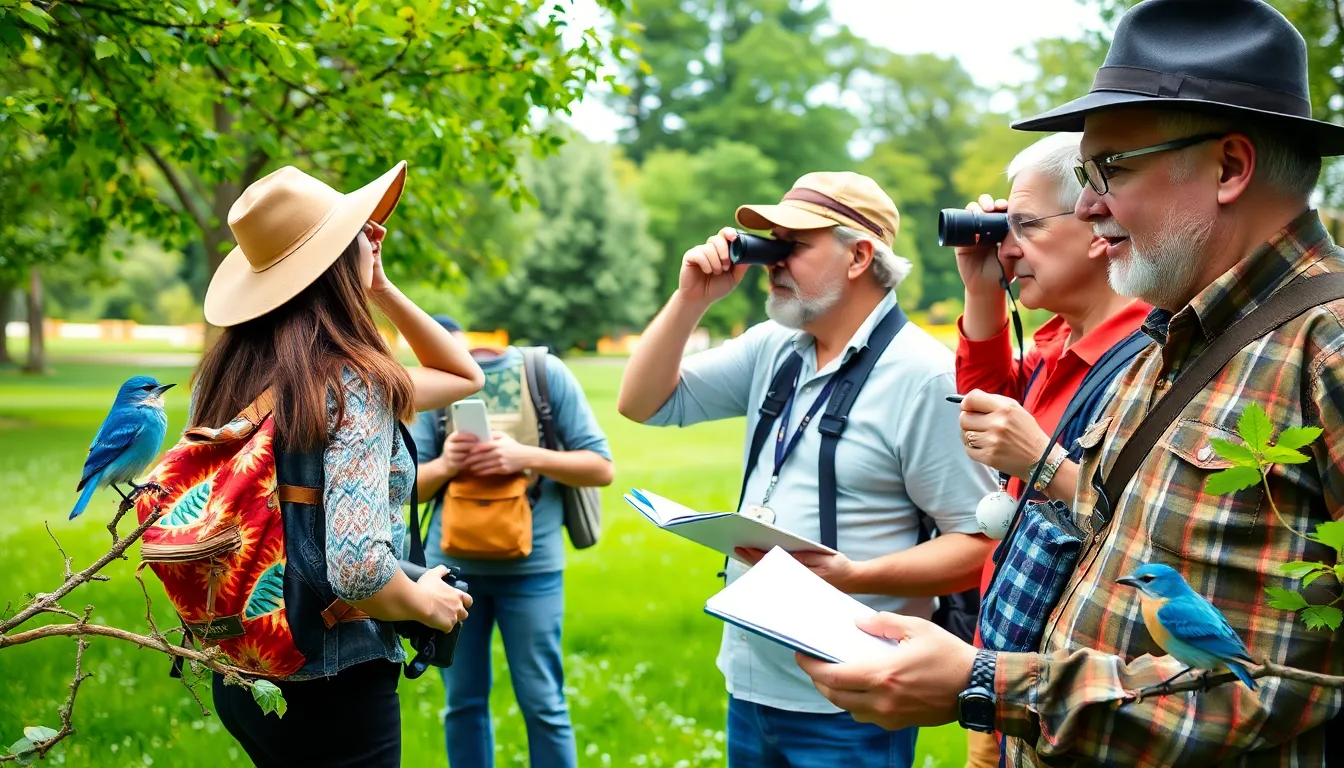
Bird enthusiasts experience distinct advantages that extend far beyond simple hobby enjoyment. These benefits cover mental wellness improvements, community connections, and meaningful contributions to conservation efforts.
Mental Health and Wellness Advantages
Bird watching provides measurable stress reduction benefits, with research documenting 78% of participants experiencing decreased anxiety levels during observation sessions. Regular birding activities enhance cognitive function through pattern recognition exercises and memory retention challenges when identifying species across different environments.
Outdoor exposure during birding excursions increases vitamin D synthesis and promotes physical activity, particularly during those 4-6 hour weekly field sessions. Morning birding routines establish healthy circadian rhythms by aligning personal schedules with natural daylight patterns.
Mindfulness practices develop naturally through focused observation techniques, requiring sustained attention on subtle movements, calls, and behaviors. These meditation-like states reduce cortisol production while improving sensory awareness and environmental sensitivity.
Social and Community Connections
Bird watching communities foster strong interpersonal relationships through shared sighting experiences and collaborative species identification efforts. Local birding groups organize regular meetups, creating social networks that span diverse age groups and professional backgrounds.
Citizen science participation connects bird people with researchers and conservationists, establishing professional relationships beyond recreational interests. Online platforms and databases help global connections, allowing enthusiasts to share regional observations and migration data with international colleagues.
Mentorship opportunities emerge naturally as experienced birders guide newcomers through species identification and habitat recognition skills. Educational workshops and birding festivals provide structured networking environments for knowledge exchange and friendship development.
Educational and Conservation Impact
Bird people contribute significantly to scientific research through systematic data collection and species monitoring programs. eBird submissions and breeding bird surveys generate valuable datasets that inform conservation policies and habitat protection initiatives.
Educational outreach activities position bird enthusiasts as environmental advocates, sharing ecological knowledge with schools, nature centers, and community organizations. Their detailed understanding of seasonal migration patterns and breeding behaviors supports habitat preservation efforts across multiple regions.
Conservation funding increases through bird watching tourism and specialty equipment purchases, generating economic incentives for habitat protection. Bird people actively support legislation protecting migratory corridors and nesting sites, leveraging their firsthand observations to advocate for exact environmental policies.
Challenges Bird People Face
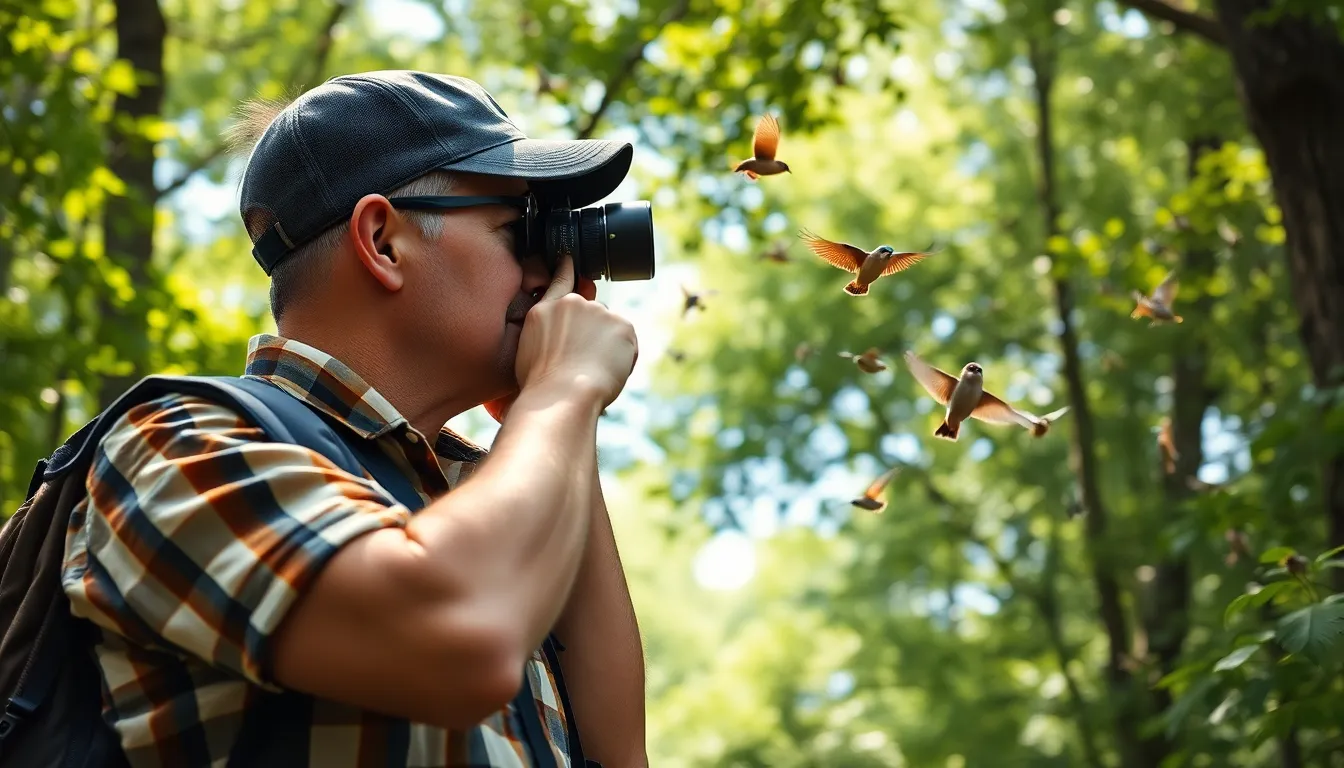
Bird enthusiasts encounter unique obstacles that distinguish their community from other nature lovers. These challenges span social perceptions, financial demands, and complex legal frameworks that govern wildlife observation.
Social Misconceptions and Stereotypes
Mainstream society often portrays bird watchers as eccentric individuals who lack social skills and live isolated lives. This stereotype damages the reputation of dedicated ornithologists who contribute valuable research to scientific communities. Many people assume bird enthusiasts prioritize animals over human relationships, creating barriers in professional and personal interactions.
Bird people face dismissive attitudes from colleagues who view their passion as childish or unproductive. Family members frequently question the time investment, particularly during peak migration seasons when enthusiasts travel extensively for rare sightings. Social media amplifies these misconceptions, with viral content depicting bird watchers as obsessive individuals who neglect practical responsibilities.
Dating platforms and social circles sometimes exclude bird enthusiasts based on preconceived notions about their lifestyle choices. Professional environments may undervalue employees who request time off for birding expeditions, viewing these requests as less legitimate than traditional vacation plans. Community members often fail to recognize the scientific contributions and conservation efforts that bird people provide through citizen science initiatives.
Financial and Time Commitments
Equipment costs create substantial financial barriers for aspiring bird enthusiasts, with quality binoculars ranging from $300 to $2,500 and telephoto lenses exceeding $5,000. Travel expenses accumulate rapidly as dedicated birders pursue rare species across multiple states and countries. Annual birding budgets average $3,200 per enthusiast, including transportation, lodging, and specialized gear maintenance.
Time management challenges arise from the unpredictable nature of bird behavior and migration patterns. Peak viewing hours occur during early morning and late evening periods, conflicting with traditional work schedules and family obligations. Seasonal commitments intensify during spring and fall migrations when optimal observation windows span several consecutive weeks.
Documentation efforts consume additional hours beyond field observations, with meticulous record keeping and photograph processing extending daily commitments. Bird people invest 15-20 hours weekly during active seasons, combining field time with data entry and community reporting responsibilities. Equipment maintenance and research preparation add another 5-8 hours monthly to existing time allocations.
Legal and Ethical Considerations
Wildlife protection laws create complex regulatory environments that bird enthusiasts must navigate carefully. Federal and state permits restrict access to sensitive habitats during breeding seasons, limiting observation opportunities for protected species. Trespassing violations occur when birders unknowingly enter private property while pursuing rare sightings, resulting in legal consequences and damaged landowner relationships.
Ethical dilemmas emerge about the use of audio playback and artificial lighting techniques that may disturb natural behaviors. Photography ethics require careful consideration of nesting sites and feeding areas to prevent habitat disruption. Some bird people struggle with balancing documentation goals against conservation principles, particularly when sharing location data for rare species.
International birding presents additional challenges through customs regulations and CITES restrictions on equipment and specimen collection. Border crossings with expensive optical equipment sometimes trigger security concerns and lengthy inspections. Conservation organizations occasionally conflict with birding communities over habitat access and visitor impact management policies.
Types of Bird People

Bird enthusiasts exist across a broad spectrum of dedication levels and specialized interests. Understanding these distinct categories reveals how different motivations and approaches shape each group’s relationship with avian species.
Casual Bird Watchers and Enthusiasts
Casual bird watchers represent the largest segment of the bird person community, captivating in observation activities 1-2 times per month during favorable weather conditions. These individuals typically identify 15-25 common species in their local area and maintain basic equipment consisting of entry level binoculars and field guides. Weekend outings and vacation birding comprise their primary observation opportunities.
Spontaneous discovery drives casual enthusiasts more than systematic documentation. They participate in community events like guided nature walks and seasonal bird counts without maintaining detailed personal records. Social media platforms serve as their preferred method for sharing occasional sightings and connecting with local birding groups.
Equipment investment remains modest among casual watchers, with spending ranges of $100-300 annually on binoculars and reference materials. Their geographic focus centers on accessible locations within 30 miles of their residence, including parks, nature centers, and suburban neighborhoods. Seasonal awareness develops gradually through repeated exposure to migration patterns and breeding behaviors.
Educational backgrounds vary widely within this group, though 65% possess college degrees and demonstrate above average environmental consciousness. Career flexibility allows participation in weekday birding events, while family commitments often influence their availability for extended field trips.
Serious Birders and Ornithologists
Serious birders dedicate 8-15 hours weekly to active field observation and species documentation. These committed enthusiasts maintain comprehensive life lists averaging 300-800 species and invest $2,000-5,000 annually in specialized equipment including high quality optics, camera gear, and travel expenses.
Advanced identification skills enable recognition of subtle plumage variations, behavioral differences, and vocalizations across multiple taxonomic families. Detailed field notebooks document weather conditions, habitat descriptions, and behavioral observations for each encounter. Photography serves both documentation and identification verification purposes.
Professional networking distinguishes serious birders through participation in regional ornithological societies and citizen science programs. eBird databases receive regular contributions from this group, with individual accounts averaging 150-300 checklists annually. Research collaboration occurs frequently with academic institutions and conservation organizations.
Geographic scope expands significantly among serious birders, with annual travel budgets supporting targeted expeditions to exact ecosystems and migration hotspots. Seasonal planning revolves around peak birding opportunities, including breeding seasons, migration periods, and rare species alerts. International birding tours attract 40% of serious birders seeking global species diversity.
Technical expertise develops through formal education, workshops, and mentorship relationships with experienced ornithologists. Software proficiency includes sound analysis programs, mapping applications, and species identification apps that enhance field capabilities.
Pet Bird Owners and Avian Caregivers
Pet bird owners represent a distinct category focused on direct animal husbandry rather than wild species observation. Daily care responsibilities consume 2-4 hours through feeding schedules, cage maintenance, and social interaction with captive birds. Veterinary relationships ensure proper health monitoring and emergency care access.
Species knowledge concentrates on domesticated varieties including cockatiels, parrots, canaries, and finches rather than wild populations. Behavioral understanding emphasizes training techniques, socialization methods, and enrichment activities that promote psychological wellbeing in captive environments.
Financial commitment reaches $1,500-3,000 annually per bird through veterinary care, specialized diets, housing upgrades, and enrichment materials. Indoor habitat design requires temperature control, lighting systems, and safety modifications that accommodate exact species requirements.
Social connections form through avian veterinarians, pet stores, and online communities dedicated to exact breeds or species. Educational focus targets captive care practices rather than field identification or conservation issues affecting wild populations.
Breeding programs engage advanced caregivers who contribute to genetic diversity preservation and species propagation efforts. Record keeping tracks lineages, health histories, and breeding outcomes that support responsible husbandry practices within the avian community.
How to Embrace Your Inner Bird Person

Embracing your inner bird person transforms casual nature appreciation into a dedicated pursuit of avian understanding. We can cultivate this passion through systematic approaches that develop both observational skills and community connections.
Starting Your Bird Journey
Beginning your bird watching journey requires minimal investment but maximum curiosity about the natural industry around you. We recommend starting with common backyard species, which typically include 8-12 easily identifiable birds such as robins, cardinals, and blue jays in most North American regions.
Basic equipment accelerates your learning curve and enhances observation quality:
- Binoculars (8×32 or 8×42) provide clear magnification without hand fatigue
- Field guide exact to your region offers detailed identification features
- Notebook or smartphone app enables systematic record keeping
- Comfortable walking shoes support extended observation periods
Timing your initial observations maximizes bird activity encounters. Early morning sessions between 6-8 AM yield the highest species diversity, while late afternoon periods from 4-6 PM offer secondary peak activity. We suggest dedicating 30-45 minutes per outing during these optimal windows to establish consistent observation habits.
Location selection influences your species exposure and learning opportunities. Local parks contain 15-25 resident species year round, while nature reserves and wildlife refuges expand your potential sightings to 40-60 species depending on habitat diversity. Urban environments surprisingly support 20-30 bird species, making city parks excellent starting locations for beginners.
Building Knowledge and Skills
Developing bird identification expertise requires systematic skill building across multiple sensory channels. We focus on visual recognition first, learning to distinguish key field marks including size comparisons, color patterns, beak shapes, and wing configurations that remain consistent across individual birds within species.
Pattern recognition accelerates through structured practice methods:
- Size comparison techniques using familiar birds like robins as reference points
- Behavioral observation noting feeding patterns, flight styles, and habitat preferences
- Seasonal variation tracking documenting plumage changes and migration timing
- Call and song recognition developing auditory identification skills
Technology enhances learning efficiency through specialized applications and resources. eBird allows systematic record keeping while contributing to citizen science databases, recording over 100 million bird observations annually from participants worldwide. Merlin Bird ID provides instant identification support through photo recognition and sound analysis, processing thousands of queries daily from birders globally.
Practice consistency builds expertise more effectively than sporadic intensive sessions. We recommend 20-30 minute daily observations over weekend marathon sessions, allowing gradual skill development and species familiarity. Regular practice develops the heightened spatial awareness and pattern recognition abilities that distinguish dedicated bird people from casual observers.
Documentation methods vary based on personal preferences but maintain consistent data collection standards:
| Method | Time Investment | Detail Level | Long-term Value |
|---|---|---|---|
| Paper notebook | 5-10 minutes | High | Excellent |
| Smartphone apps | 2-5 minutes | Medium | Good |
| Photography logs | 10-15 minutes | Very high | Excellent |
| Audio recordings | 3-8 minutes | Medium | Good |
Connecting with the Bird Community
Bird watching communities provide essential support networks that accelerate learning and enhance enjoyment of avian pursuits. We find that local Audubon Society chapters offer structured programs including guided walks, species identification workshops, and conservation project participation opportunities.
Online platforms connect bird enthusiasts across geographic boundaries, enabling knowledge sharing and collaborative species monitoring. Facebook groups dedicated to regional birding contain 500-2000 active members sharing daily sightings, identification assistance, and location recommendations. Reddit communities like r/birding help global discussions among 400,000+ subscribers exchanging photos and expertise.
Citizen science participation transforms personal observations into valuable research contributions. Christmas Bird Count engages 80,000+ volunteers annually, generating data used by conservation organizations and academic researchers. Breeding Bird Survey participants contribute systematic population monitoring data that influences habitat protection policies and species management decisions.
Mentorship relationships accelerate skill development through experienced birder guidance. We recommend connecting with established bird people who demonstrate expertise in areas matching your interests, whether focused on identification skills, photography techniques, or conservation advocacy. Most experienced birders welcome opportunities to share knowledge with enthusiastic beginners.
Social birding events create supportive learning environments while building lasting friendships. Local bird clubs organize weekly walks averaging 6-12 participants, monthly presentations featuring expert speakers, and annual festivals celebrating seasonal migrations. These gatherings provide opportunities to observe experienced birders’ techniques while contributing your own observations to group knowledge.
Professional development opportunities exist for bird people seeking career advancement in related fields. Wildlife biology positions, environmental consulting roles, and eco-tourism guide jobs value the observational skills and ecological knowledge that dedicated bird enthusiasts develop through years of practice.
Conclusion
The industry of bird enthusiasts reveals a fascinating community driven by curiosity scientific observation and deep environmental awareness. We’ve explored how these individuals transform simple nature appreciation into meaningful contributions to conservation and citizen science.
Whether you’re a casual backyard observer or considering joining local birding groups the path forward is clear. The birding community welcomes newcomers with open arms offering mentorship and shared knowledge that enriches every outdoor experience.
The unique blend of mental wellness benefits social connections and environmental advocacy makes bird watching more than just a hobby—it’s a lifestyle that connects us to the natural industry in profound ways. Your journey as a bird person starts with a single step outside and a willingness to look up.
Frequently Asked Questions
What is a “bird person” and how are they different from regular nature lovers?
A bird person is someone with an intense fascination for avian species who transforms their passion into a lifestyle focused on understanding bird behavior and ecology. Unlike casual nature lovers, bird people possess heightened spatial awareness, exceptional pattern recognition abilities, and methodical thinking. They often catalog encounters with different species, maintain detailed records, and structure their days around natural rhythms and seasonal changes.
What personality traits are common among bird enthusiasts?
Research shows bird people typically exhibit openness to experience, conscientiousness, and introversion. Those high in openness seek novel experiences and enjoy unpredictable bird encounters. Conscientious bird enthusiasts meticulously document sightings and plan excursions with precision. Introverted bird people excel in solitary observation, allowing them to notice subtle details others might miss, along with enhanced pattern recognition abilities.
How do bird people differ from traditional pet owners?
Bird enthusiasts prioritize observation and environmental awareness over companionship, spending 4-6 hours weekly in field observations versus pet owners’ 2-3 hours daily on direct care. Bird people develop one-sided fascination based on respect for wild creatures’ independence, while pet owners seek mutual affection. They also focus on habitat conservation and species protection rather than individual animal welfare.
What are the mental health benefits of bird watching?
Bird watching significantly improves mental wellness, with 78% of participants reporting reduced anxiety during observation sessions. Regular birding enhances cognitive function, promotes physical activity, and increases vitamin D synthesis through outdoor exposure. Mindfulness practices naturally develop through focused observation, leading to improved sensory awareness and overall psychological well-being.
What challenges do bird enthusiasts commonly face?
Bird people often encounter social misconceptions and stereotypes portraying them as eccentric and socially isolated, which can hinder personal and professional relationships. Financial barriers exist due to equipment and travel costs, plus time management issues from unpredictable bird behavior. They must also navigate legal restrictions and wildlife protection laws that can limit habitat access.
How can beginners start their bird watching journey?
Starting requires minimal investment but maximum curiosity. Begin with common backyard species using basic equipment like binoculars and field guides. Focus on early morning and late afternoon sessions for optimal encounters. Practice systematic bird identification through visual recognition, behavioral observation, and seasonal tracking. Join local birding clubs and use smartphone apps for documentation and community connection.
What types of bird enthusiasts exist?
There are three main categories: Casual bird watchers engage 1-2 times monthly, identifying 15-25 common species with basic equipment. Serious birders dedicate 8-15 hours weekly, maintaining extensive life lists and investing in specialized gear. Pet bird owners focus on domesticated bird husbandry rather than wild species observation. Each reflects different motivations and approaches to avian relationships.
How do bird people contribute to conservation efforts?
Bird enthusiasts actively participate in citizen science projects, contributing valuable data to conservation research through programs like the Christmas Bird Count. They support legislation preserving migratory corridors and nesting sites, using firsthand observations to advocate for environmental policies. Their tourism and equipment purchases generate funding for habitat protection, while educational outreach positions them as environmental advocates.

